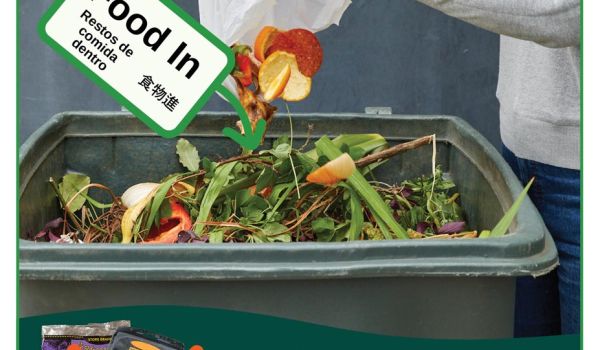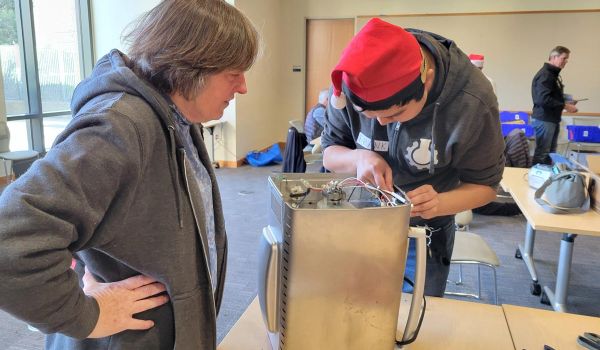Edible Food Recovery Program: Deliver food where it’s needed and connect with your community
By admin
Getting food to people who need it while also reducing food waste requires many hands. As one food recovery non-profit leader said, “We need everybody to get involved. It’s not like one group can do the best job. It’s a spectrum all the way from the farmers to the families.” And, especially important are the volunteers! A robust network of community members committed to food recovery – moving surplus food from businesses like grocery stores to individuals and families facing food insecurity – exists in San Mateo County. Everyone is welcome to participate.
Food recovery feeds our neighbors

We all know there’s surplus inventory and leftover meals from places like supermarkets, corporate dining rooms, and restaurants. What happens to this food? How much food is it?
About 40% of food produced in the U.S., including fresh fruits and vegetables, prepared meals, and packaged foods, gets thrown into landfills every year. This waste can be due to businesses purchasing too much food, as well as factors like a food’s appearance, age, freshness, grade, and size that make it less desirable for customers or cooks.
This food is often still delicious and safe to eat. Instead of throwing it away, it can feed people in our communities, such as those who are food insecure but don’t qualify for the Supplemental Nutrition Assistance Program (SNAP). For example, in San Mateo County, 30-40% of residents worry about having enough food for the day or week, but don’t qualify for CalFresh benefits.
Samaritan House, a non-profit based in San Mateo that provides services to people living in poverty, is one organization in a network of volunteer-based organizations in San Mateo County that help recover surplus food and distribute it to individuals and families.
“Food recovery helps our community members offset some of the cost of buying groceries,” explained Reyna Sandoval, Samaritan House’s Director of Food & Community Programs. “Without edible food recovery, we wouldn’t be able to provide groceries or make all these meals. We would have to say ‘no’ to the many requests we get from places like senior housing and from homebound individuals because our budget wouldn’t allow it.”
Arleen Pineda, a founder of Circle of Inspiration, which distributes boxes of food to families in need, shared a similar sentiment. “We support 30 families a week with surplus food here in South San Francisco,” she said. “We go through the donations we get and rescue as many units as we can. Some of the families are unhoused and have small children. We give them food and also connect them to resources.”
Saving food that would otherwise go to waste and distributing it to community members who need it is one clear benefit of the San Mateo County Edible Food Recovery Program. In addition, reducing food waste has a positive impact on the environment.
Food recovery fights climate change
Many of us probably don’t think about how food waste affects the environment – food rots, so it must be OK to landfill it, right? Not exactly. When food waste is buried in the landfill, it’s starved of oxygen. Then, instead of being broken down by oxygen-loving microbes into compost, food in the landfill decomposes in a way that generates a significant amount of methane. Methane is a greenhouse gas that traps the sun’s heat in the atmosphere and contributes to global warming. Methane is more than 28 times more potent than the carbon dioxide (CO2) emitted from burning fossil fuels.
Nearly a quarter of all of the solid waste in landfills is food waste. Therefore, it shouldn’t be a surprise that landfills are the third-largest source of methane emissions (from human activities) in the U.S. In addition, when we waste food, we’re also wasting resources like the water and energy that were used to grow, harvest, manufacture, package, transport, and prepare the food.
By focusing on decreasing food waste, we can reduce our overall carbon footprint, which can make a significant impact on the fight to slow climate change.
How the EFR Program works: Connecting food-generating businesses and food recovery organizations
Some businesses in San Mateo County have been donating surplus food to organizations like food banks for years. In 2024, it became mandatory for all large food generators to comply with the edible food recovery requirements in Senate Bill 1383 (SB 1383), which took effect in 2022.
SB 1383 requires jurisdictions to implement an edible food recovery program to save surplus food from ending up in the landfill, feed people who may be experiencing food insecurity, create new green jobs, strengthen relationships between food donors and food recovery organizations, and help build capacity for food recovery organizations to recover food. A pillar of the program is a requirement for the largest food-generating businesses across the county to work with food recovery organizations to recover all of their surplus edible food.
Businesses in San Mateo County can determine if they are required to donate to food recovery organizations by visiting the Edible Food Recovery Program page on the Sustainability Department’s website.
Food-generating partners

Large food-generating businesses in California, such as supermarkets, grocery stores, food service providers, wholesalers, restaurants, hotels, event venues, and hospitals, are required by SB 1383 to contract with food recovery organizations and work with them to donate the maximum of their surplus food.
Founder and Executive Director Maria Yapp of Peninsula Food Runners, a non-profit solely dedicated to food recovery, says that while providing food to as many people as possible is important, San Mateo businesses should also think about the impact they can make in their immediate communities.
“I tell my donors they have a choice: do you want to feed the people around you? You can make such a difference by asking your caterers and corporate dining to keep the food here in the community,” said Yapp.
The San Mateo County Edible Food Recovery Program helps food-generating businesses comply with California law and donate their surplus food, including prepared food from deli counters and dining rooms. The San Mateo County Sustainability Department provides businesses with hands-on technical assistance, such as how to navigate the new food donation requirements, identify different food recovery organizations and services, determine how to donate the maximum amount of surplus food – and reduce landfill waste in the process.
The County has been inspecting large food generators since 2023 to determine compliance with the requirements. Fines for continued noncompliance will begin in late 2025.
Food recovery organizations
The San Mateo County Edible Food Recovery Program helps connect food generators and food recovery organizations. Food recovery organizations pick up surplus food from edible food-generating businesses and either directly distribute donated food to people or deliver it to recipient organizations that make it accessible to individuals and families. Recipients include soup kitchens, food pantries, affordable housing complexes, and senior housing, as well as organizations that deliver mobile meals to homebound individuals and set up grocery box pick-up locations in local neighborhoods.
“We’re fortunate that many of our donor partners put in quite a bit of effort to make sure that we get some really nice inventory from their stores, including produce, protein, prepared food, and desserts, and also products like detergent and toiletries,” said Sandoval of Samaritan House.
Because “picking up food is not many non-profits’ main mission,” as Yapp of Peninsula Food Runners explained, food recovery organizations function as critical partners. They help community-based organizations focus on what they do best, such as providing services and programs for healthcare, child care, housing, and employment.
In addition, food recovery organizations are essential for helping to strategically move surplus food to where it’s needed in a timely manner, while it’s fresh. “We need to make sure we do food recovery intelligently to get food to the right place,” said Sandoval.
Yapp of Peninsula Food Runners also emphasized the important environmental impact of the work, in addition to the social and economic impact. “I’m not here to perpetuate recovery,” she said. “We want to help recover until the donors learn how to manage their food, so they don’t have so much surplus. That’s truly our end goal. When that happens, I can go and concentrate on other groups that haven’t done it.”
The network of food recovery organizations operating throughout San Mateo County ranges from small, grass-roots non-profits running out of volunteers’ homes, to larger community-based organizations that provide many services and programs in addition to groceries and hot meals. To see which food recovery organizations operate near you, click on the map below.
Edible food recovery is making an impact
Since 2022, the San Mateo County Edible Food Recovery Program has supported the donation of approximately 16.6 million meals for individuals and families in San Mateo County. That’s a lot of meals! But what’s the individual-level impact of providing meals and groceries to our communities? There are so many stories – about people who could be our neighbors, friends, and family members.
For example, there’s a senior gentleman on a small, fixed budget who can now have coffee with his friends and not worry so much about having those extra dollars set aside for buying food. There’s a family that doesn’t have to choose between a nutritious dinner and buying diapers and medicine. There’s also a single working mom who has more quality time to spend with her kids in the evening because she doesn’t have to cook. There’s a woman undergoing cancer treatment whose family was fed with a meal train. And there’s an elderly couple who can shop at a free market and socialize with the staff – who can check in with them to see how they’re doing.
Food is an essential ingredient to building a healthy community. When we share a meal and connect with others, as Sandoval of Samaritan House explained, “our bellies are full, and our hearts are nourished.”
How to get involved

Community members can support food recovery efforts in San Mateo County by volunteering with a food recovery organization. These organizations welcome support from volunteers who want to help pick up and deliver food donations, prepare grocery boxes, stock shelves, and cook meals. Some organizations also need volunteers to help with administration, language translation, events, and technology support.
The wide variety of food recovery organizations and the tasks they need help with means there are many different options for volunteers. This flexibility helps many people – including students, parents and kids, corporate groups, friend groups, and retirees – fit food recovery volunteering into their schedules.
“We have moms who do food runs during their kids’ sports practices,” said Yapp of Peninsula Food Runners.
“We’re always looking for volunteers,” said Pineda of Circle of Inspiration. “The great thing about this community is that when one of the distributors isn’t available, we can reach out to the group – and people are willing to pick up from San Mateo to deliver here or wherever it’s needed.”
A lot of our volunteers have been with us for many years,” said Sandoval of Samaritan House.
“We’re fortunate that we have a network of people that are able to help us do all this great work in the community.”
Inspired by this story? Get involved with edible food recovery in San Mateo County! To learn more about the San Mateo County Edible Food Recovery Program, see the program page on the Sustainability Department website. To find volunteer opportunities, click on the map below.
We are committed to building a sustainable community that fulfills the needs of the present and future.
Get Involved
Help us build innovative solutions that address today’s changing environment while solving for a sustainable future.



